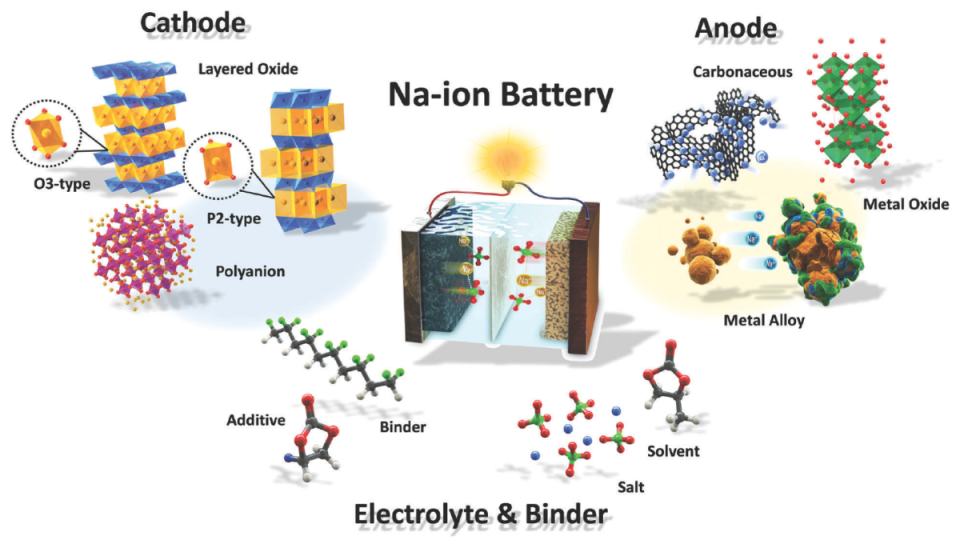Sparking Change: Are Sodium-Ion Batteries Going To Replace Lithium-Ion In The Future?

Bruno Long
In the relentless pursuit of sustainable energy solutions, sodium-ion batteries have emerged as a promising contender challenging the longstanding dominance of lithium-ion technology. The principles governing sodium-ion batteries draw inspiration from their lithium-ion counterparts, yet their unique characteristics and advantages set them apart in the evolving landscape of energy storage.
Sodium-ion batteries operate on the basic electrochemical principles shared by various battery technologies. During the discharge phase, sodium ions migrate from the anode to the cathode through an electrolyte, generating an electrical current.
Conversely, during charging, the ions move back to the anode, storing energy for subsequent use. This mechanism mirrors the operation of lithium-ion batteries, but the substitution of sodium for lithium offers distinctive benefits and addresses some of the inherent challenges associated with lithium-based systems.

Wikipedia
Unlike lithium, sodium is abundant and widely available, potentially mitigating concerns related to resource scarcity and geopolitical dependencies. The cost-effectiveness and sustainable nature of sodium-ion batteries make them an attractive prospect for the energy storage sector.
While lithium-ion batteries have held sway for several decades, sodium-ion technology has been in development since the early 2000s, gaining traction as researchers and engineers strive to overcome its initial limitations.
As sodium-ion batteries mature, the technology is poised to carve out a niche in the energy storage ecosystem. With ongoing advancements aimed at improving energy density, cycle life, and overall performance, sodium-ion batteries hold the promise of revolutionizing how we store and utilize energy in the coming years.
With the promise of lower cost, improved safety, and a more abundant resource base, sodium-ion batteries are sparking a heated debate on whether they could eventually dethrone the reigning lithium-ion technology.

Denago Ebikes
Lithium-Ion Batteries
Pros | Cons |
|---|---|
–Energy Density –Established Technology –Efficiency & Performance | –Limited Resources –Safety Concers –Environmental Impact |
Pros of Lithium-Ion Batteries
Energy Density
Lithium-ion batteries have been the backbone of portable electronics and electric vehicles due to their high energy density. This allows them to store a significant amount of energy in a relatively compact and lightweight package, making them ideal for applications where space and weight are critical factors.
Established Technology
Lithium-ion batteries have a head start in terms of technological maturity. They have undergone decades of research and development, resulting in a well-established manufacturing infrastructure. This maturity translates to reliability and widespread adoption, further driving down costs.
Efficiency and Performance
Lithium-ion batteries boast excellent efficiency and performance, with low self-discharge rates and a minimal memory effect. This makes them a reliable choice for a wide range of applications, from powering smartphones to supporting renewable energy storage projects.
Cons of Lithium-Ion Batteries
Limited Resource Availability
One significant drawback of lithium-ion batteries is their reliance on scarce and expensive materials, such as cobalt and lithium. The mining and extraction of these resources contribute to environmental concerns, and the geopolitical challenges surrounding their supply chain can lead to price volatility.
Safety Concerns
Lithium-ion batteries have faced safety issues, including overheating, fires, and explosions. The highly reactive nature of lithium poses risks, especially when exposed to extreme conditions or manufacturing defects. These safety concerns have led to a continuous search for alternative technologies.
Environmental Impact
The environmental impact of lithium-ion batteries extends beyond resource extraction. The disposal and recycling of these batteries present challenges, as improper handling can lead to soil and water contamination. Addressing these environmental issues is crucial for a sustainable energy future.

Bruno Long
Sodium-Ion Batteries
Pros | Cons |
|---|---|
–Abundant Resources –Lower Cost –Improved Safety | –Low Energy Density –Technological Challenges –Limited Applications |
Pros of Sodium-Ion Batteries
Abundant Resources
Sodium-ion batteries offer a more sustainable alternative, as sodium is abundant and widely available. This reduces concerns about resource scarcity and geopolitical tensions, potentially leading to a more stable and cost-effective energy storage solution.
Lower Cost
Sodium-ion batteries have the potential for lower production costs compared to lithium-ion batteries. With sodium being a more abundant and affordable resource, the overall manufacturing expenses could be reduced, making energy storage more economically viable.
Improved Safety
Sodium-ion batteries are considered safer than their lithium-ion counterparts. Sodium is less prone to thermal runaway reactions, reducing the risk of overheating and fire incidents. This enhanced safety profile could open up new possibilities for widespread adoption in various applications.

Aventon
Cons of Sodium-Ion Batteries
Lower Energy Density
One of the main challenges facing sodium-ion batteries is their lower energy density compared to lithium-ion batteries. This means that, for the same volume and weight, sodium-ion batteries store less energy, limiting their application in high-energy-demand scenarios such as electric vehicles.
Technological Challenges
Sodium-ion battery technology is still in the early stages of development compared to lithium-ion batteries. Overcoming technological challenges, such as optimizing electrode materials and increasing cycle life, is crucial for sodium-ion batteries to become a competitive alternative.
Limited Application Scope
While sodium-ion batteries may be suitable for certain stationary energy storage applications, they may not be as versatile as lithium-ion batteries. The latter has proven its efficacy across a wide range of devices and industries, from consumer electronics to electric vehicles.
Related: Electric Bike Batteries 101 (From Types and Voltage to Lingo)
Where Things Stand
The debate between sodium-ion and lithium-ion batteries is a nuanced one, with each technology presenting a unique set of advantages and challenges. While lithium-ion batteries have dominated the energy storage landscape for decades, the quest for sustainability and affordability is driving the exploration of alternatives like sodium-ion batteries.
The future of energy storage may involve a diversified portfolio, with different technologies catering to specific applications. The ongoing research and development in both sodium-ion and lithium-ion battery technologies will ultimately shape the trajectory of the energy storage industry.
As we weigh the pros and cons of each, it is essential to recognize that the journey toward a more sustainable and efficient energy future may involve a combination of these technologies rather than a clear winner-takes-all scenario.

